Overview
- Two common data formats: CSV and JSON
- Use Python's csv module to process weather data stored in the CSV format and analyze high and low temperatures over time in two different locations.
- Use Matplotlib to generate a chart based on our downloaded data display variations in temperature in two dissimilar environments: Stika, Alaska, and Death Valley, California.
- Use the json module to access earthquake data stored in the GeoJSON format
- Use Plotly to draw a world map showing the location and magnitude of recent earthquakes.
1.The CSV File Format
One simple way to store data in the text file is to write the data as a series of values separated by commas, called comma-separated values.

2.Parsing the CSV File Headers
from pathlib import Path
import csv
path = Path('weather_data/sitka_weather_07-2021_simple.csv')
lines = path.read_text().splitlines()
reader = csv.reader(lines)
header_row = next(reader)
print(header_row)3. Printing the Headers and Their Positions
from pathlib import Path
import csv
path = Path('weather_data/sitka_weather_07-2021_simple.csv')
lines = path.read_text().splitlines()
reader = csv.reader(lines)
header_row = next(reader)
#print(header_row)
for index, column_header in enumerate(header_row):
print(index, column_header)
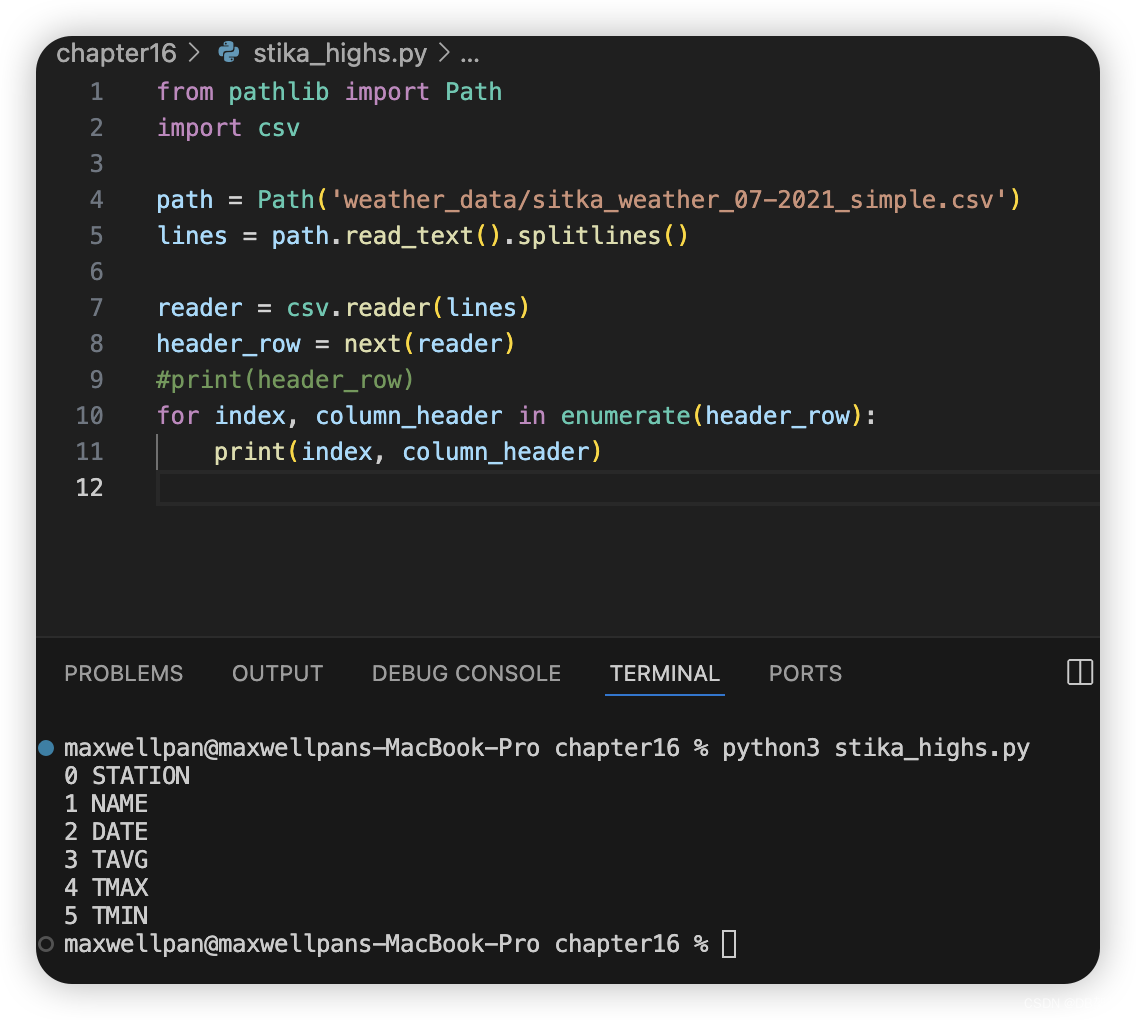
4.Extracting and Reading Data
from pathlib import Path
import csv
path = Path('weather_data/sitka_weather_07-2021_simple.csv')
lines = path.read_text().splitlines()
reader = csv.reader(lines)
header_row = next(reader)
# Extract high temperatures.
highs = []
for row in reader:
high = int(row[4])
highs.append(high)
print(highs)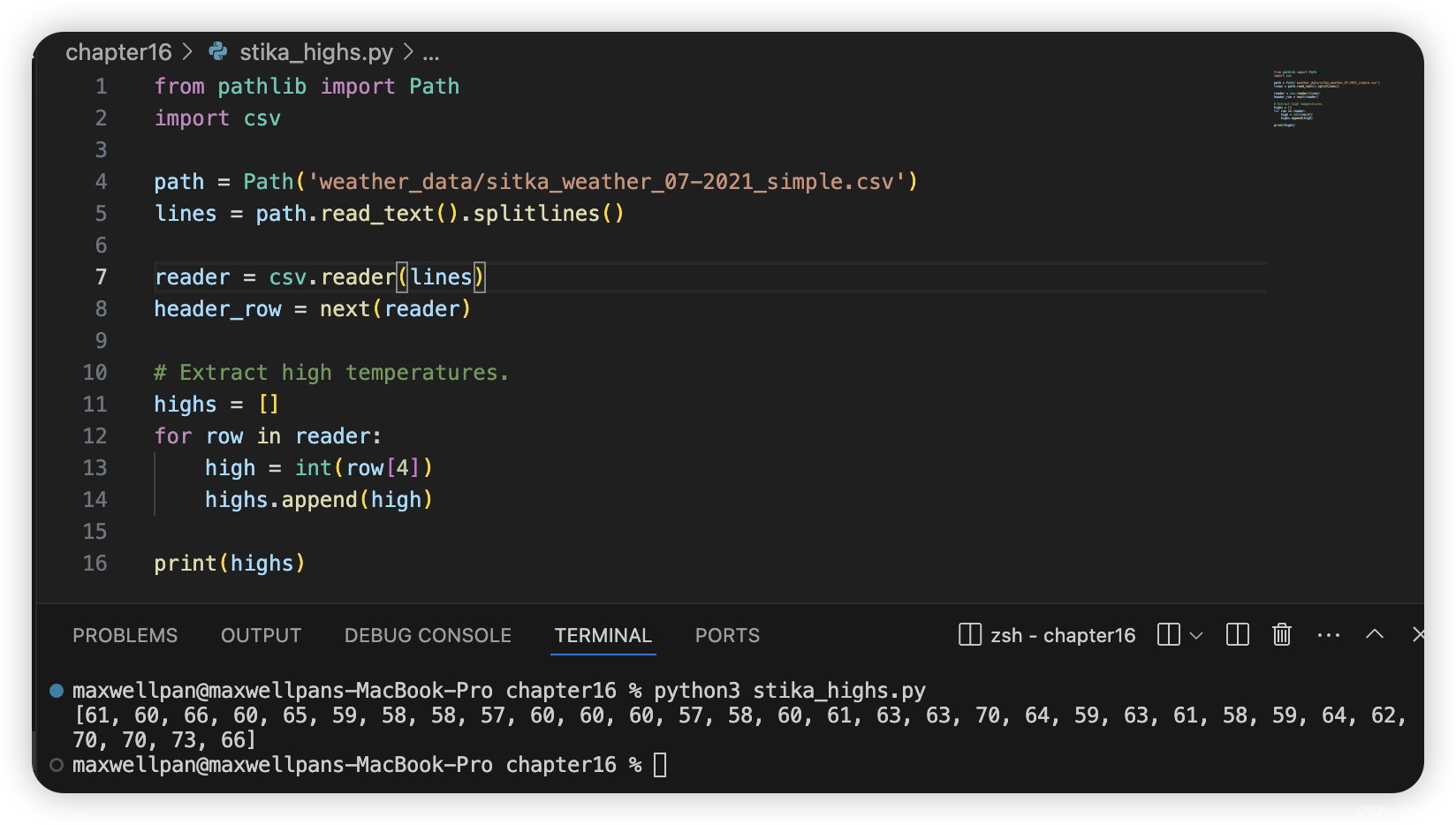
5.Plotting Data in a Temperature Chart
from pathlib import Path
import csv
import matplotlib.pyplot as plt
path = Path('weather_data/sitka_weather_07-2021_simple.csv')
lines = path.read_text().splitlines()
reader = csv.reader(lines)
header_row = next(reader)
# Extract high temperatures.
highs = []
for row in reader:
high = int(row[4])
highs.append(high)
print(highs)
# Plot the high temperatures.
plt.style.use('seaborn-v0_8')
fig, ax = plt.subplots()
ax.plot(highs, color='red')
# Format plot.
ax.set_title("Daily High Temperatures, July 2021", fontsize=24)
ax.set_xlabel('',fontsize=16)
ax.set_ylabel("Temperature(F)", fontsize=16)
ax.tick_params(labelsize=16)
plt.show()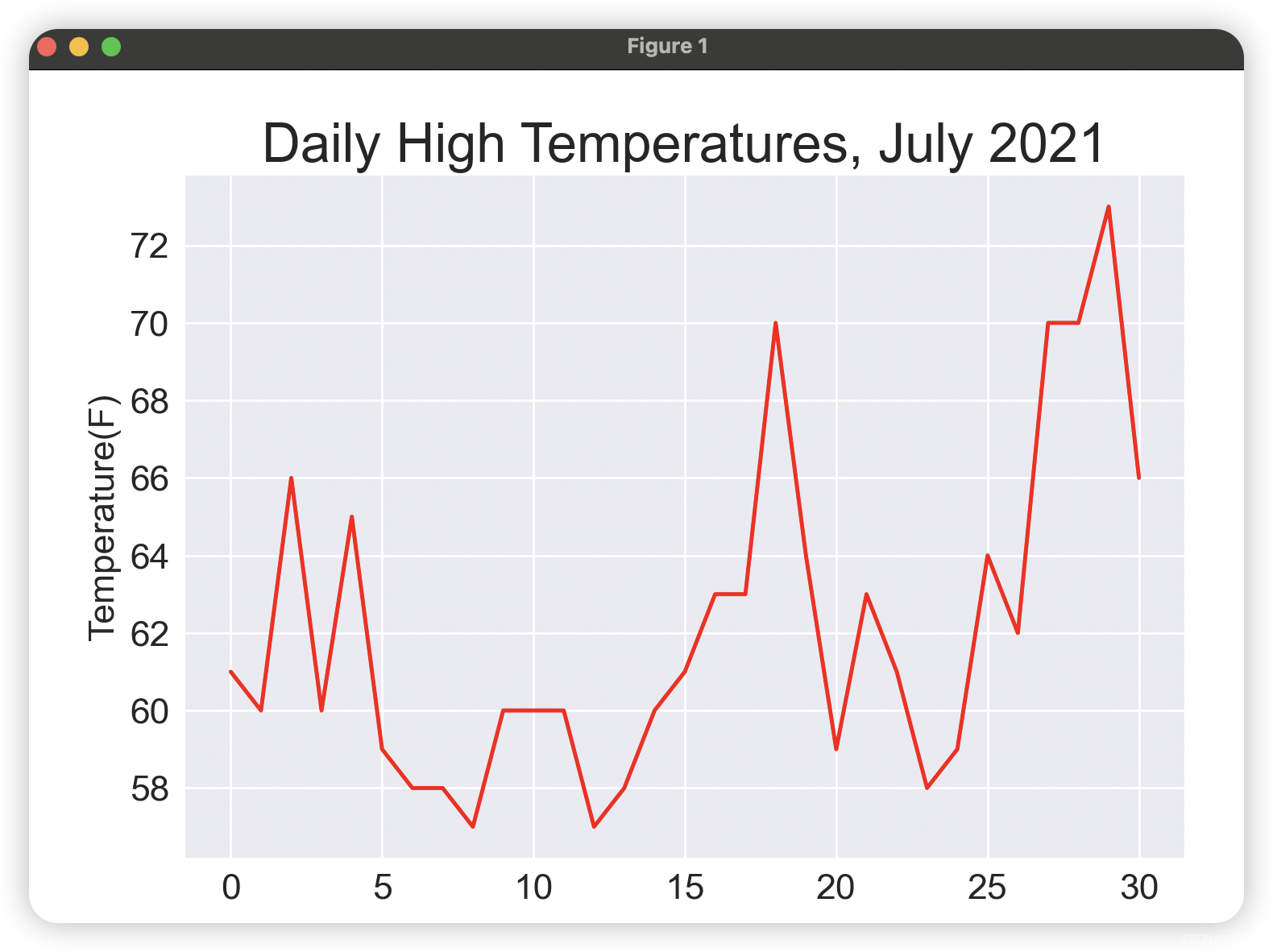
6.The datetime Module


7.Plotting Dates
from pathlib import Path
import csv
from datetime import datetime
import matplotlib.pyplot as plt
path = Path('weather_data/sitka_weather_07-2021_simple.csv')
lines = path.read_text().splitlines()
reader = csv.reader(lines)
header_row = next(reader)
# Extract high temperatures.
dates, highs = [],[]
for row in reader:
current_date = datetime.strptime(row[2], '%Y-%m-%d')
high = int(row[4])
dates.append(current_date)
highs.append(high)
print(highs)
# Plot the high temperatures.
plt.style.use('seaborn-v0_8')
fig, ax = plt.subplots()
ax.plot(dates,highs, color='red')
# Format plot.
ax.set_title("Daily High Temperatures, July 2021", fontsize=24)
ax.set_xlabel('',fontsize=16)
fig.autofmt_xdate()
ax.set_ylabel("Temperature(F)", fontsize=16)
ax.tick_params(labelsize=16)
plt.show()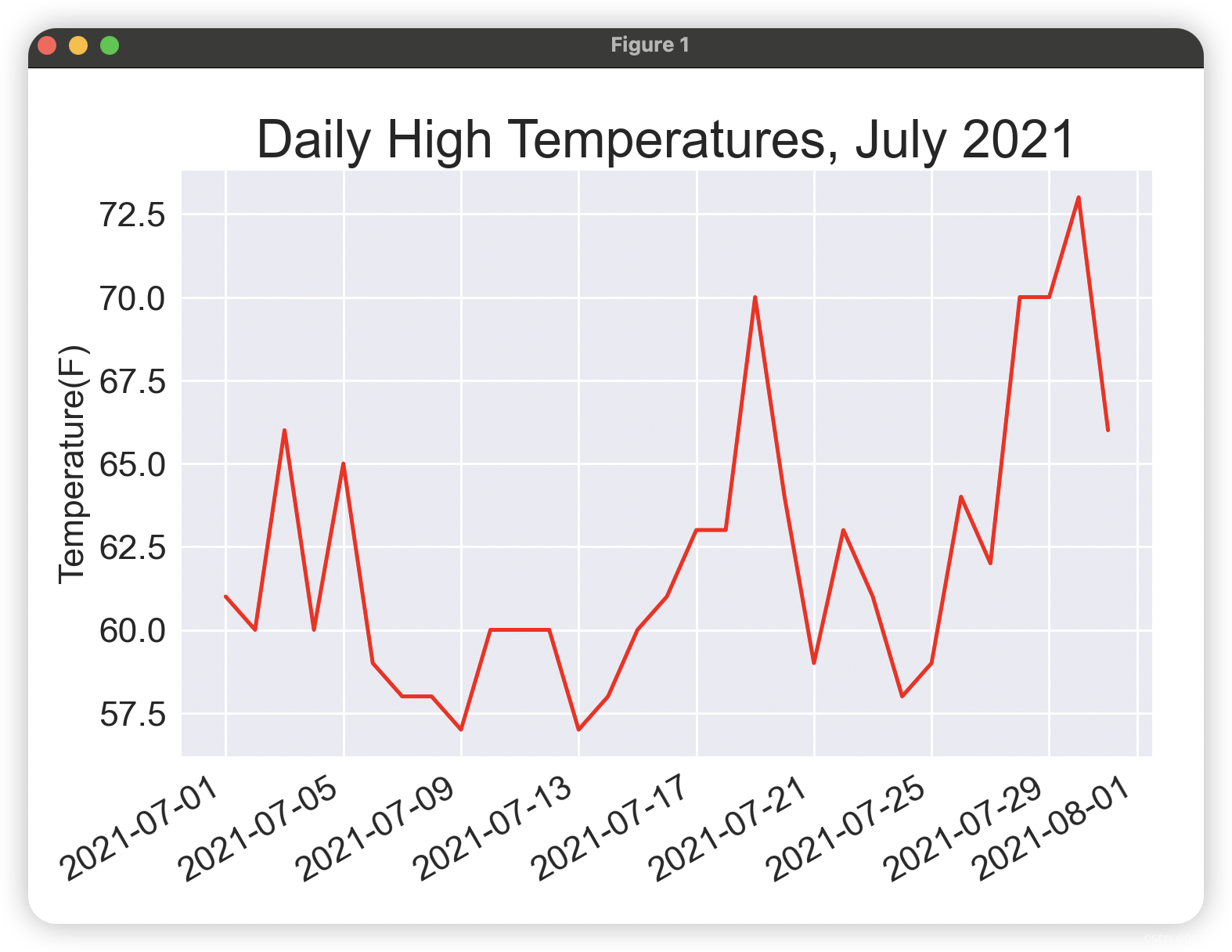
8.Plotting a Longer Timeframe
from pathlib import Path
import csv
from datetime import datetime
import matplotlib.pyplot as plt
path = Path('weather_data/sitka_weather_2021_simple.csv')
lines = path.read_text().splitlines()
reader = csv.reader(lines)
header_row = next(reader)
# Extract high temperatures.
dates, highs = [],[]
for row in reader:
current_date = datetime.strptime(row[2], '%Y-%m-%d')
high = int(row[4])
dates.append(current_date)
highs.append(high)
print(highs)
# Plot the high temperatures.
plt.style.use('seaborn-v0_8')
fig, ax = plt.subplots()
ax.plot(dates,highs, color='red')
# Format plot.
ax.set_title("Daily High Temperatures, 2021", fontsize=24)
ax.set_xlabel('',fontsize=16)
fig.autofmt_xdate()
ax.set_ylabel("Temperature(F)", fontsize=16)
ax.tick_params(labelsize=16)
plt.show()
9.Plotting a Second Data Series
from pathlib import Path
import csv
from datetime import datetime
import matplotlib.pyplot as plt
path = Path('weather_data/sitka_weather_2021_simple.csv')
lines = path.read_text().splitlines()
reader = csv.reader(lines)
header_row = next(reader)
# Extract high temperatures.
dates, highs, lows = [],[],[]
for row in reader:
current_date = datetime.strptime(row[2], '%Y-%m-%d')
high = int(row[4])
low = int(row[5])
dates.append(current_date)
highs.append(high)
lows.append(low)
# Plot the high and low temperatures.
plt.style.use('seaborn-v0_8')
fig, ax = plt.subplots()
ax.plot(dates,highs, color='red')
ax.plot(dates, lows, color='blue')
# Format plot.
ax.set_title("Daily High and Low Temperatures, 2021", fontsize=24)
ax.set_xlabel('',fontsize=16)
fig.autofmt_xdate()
ax.set_ylabel("Temperature(F)", fontsize=16)
ax.tick_params(labelsize=16)
plt.show()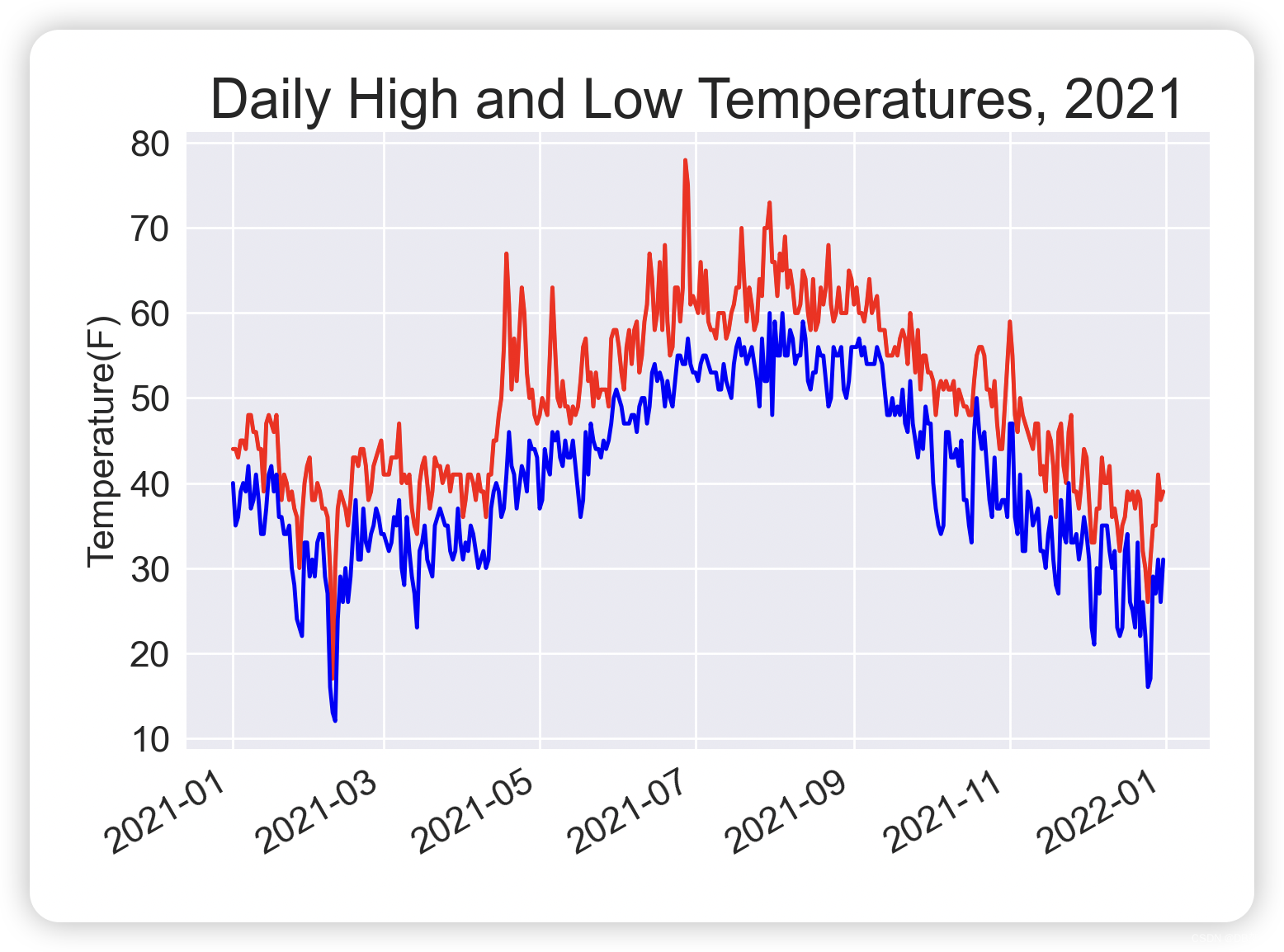
10.Shading an Area in the Chart
from pathlib import Path
import csv
from datetime import datetime
import matplotlib.pyplot as plt
path = Path('weather_data/sitka_weather_2021_simple.csv')
lines = path.read_text().splitlines()
reader = csv.reader(lines)
header_row = next(reader)
# Extract high temperatures.
dates, highs, lows = [],[],[]
for row in reader:
current_date = datetime.strptime(row[2], '%Y-%m-%d')
high = int(row[4])
low = int(row[5])
dates.append(current_date)
highs.append(high)
lows.append(low)
# Plot the high and low temperatures.
plt.style.use('seaborn-v0_8')
fig, ax = plt.subplots()
ax.plot(dates, highs, color='red', alpha=0.5)
ax.plot(dates, lows, color='blue', alpha=0.5)
ax.fill_between(dates, highs, lows, facecolor='blue', alpha=0.1)
# Format plot.
ax.set_title("Daily High and Low Temperatures, 2021", fontsize=24)
ax.set_xlabel('',fontsize=16)
fig.autofmt_xdate()
ax.set_ylabel("Temperature(F)", fontsize=16)
ax.tick_params(labelsize=16)
plt.show()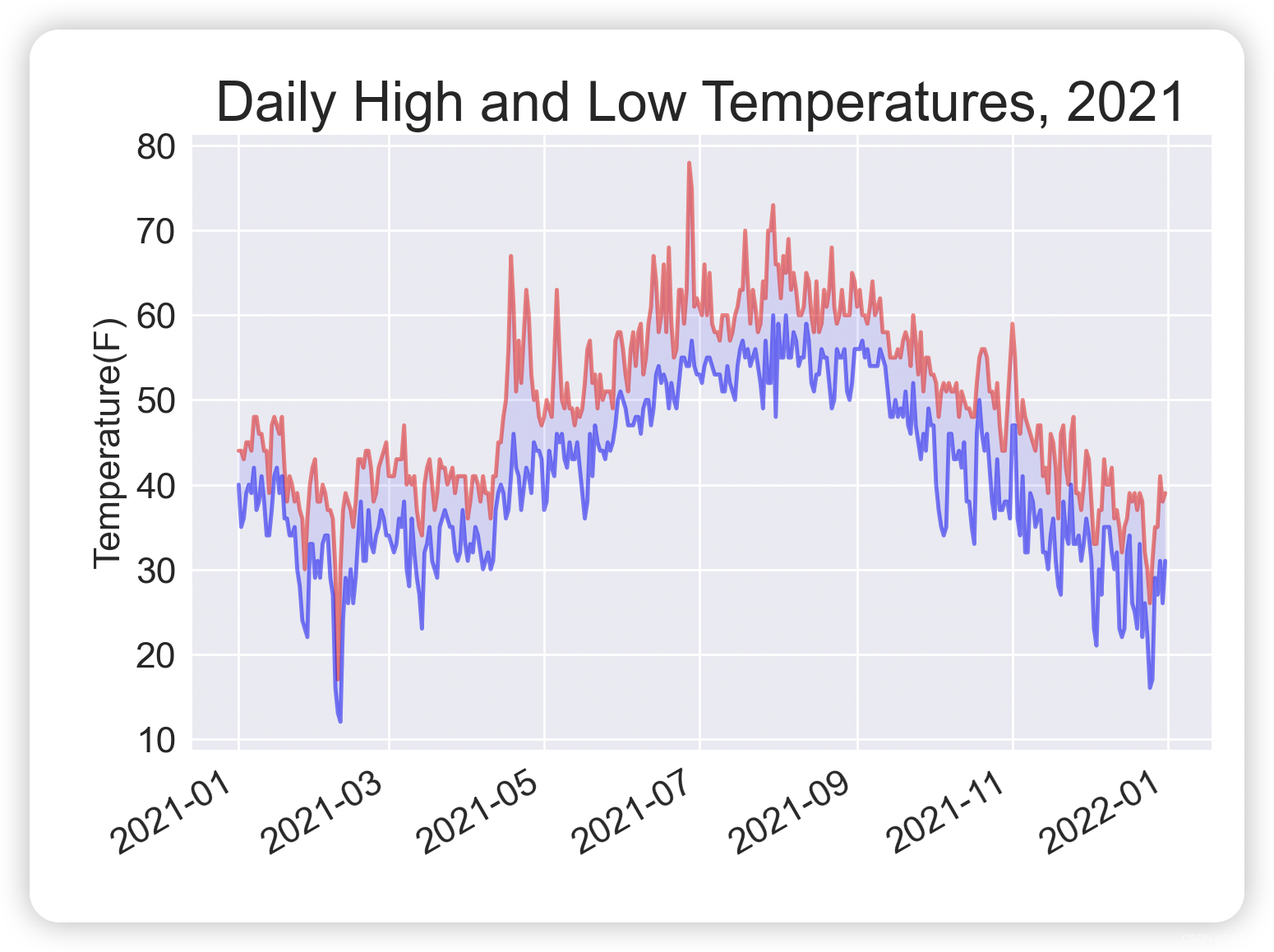
11.Error Checking
from pathlib import Path
import csv
from datetime import datetime
import matplotlib.pyplot as plt
path = Path('weather_data/death_valley_2021_simple.csv')
lines = path.read_text().splitlines()
reader = csv.reader(lines)
header_row = next(reader)
for index, column_header in enumerate(header_row):
print(index, column_header)
# Extract dates, and high and low temperatures.
dates, highs, lows = [],[],[]
for row in reader:
current_date = datetime.strptime(row[2], '%Y-%m-%d')
try:
high = int(row[3])
low = int(row[4])
except ValueError:
print(f"Missing data for {current_date}")
else:
dates.append(current_date)
highs.append(high)
lows.append(low)
# Plot the high and low temperatures.
plt.style.use('seaborn-v0_8')
fig, ax = plt.subplots()
ax.plot(dates, highs, color='red', alpha=0.5)
ax.plot(dates, lows, color='blue', alpha=0.5)
ax.fill_between(dates, highs, lows, facecolor='blue', alpha=0.1)
# Format plot.
ax.set_title("Daily High and Low Temperatures, 2021", fontsize=24)
ax.set_xlabel('',fontsize=16)
fig.autofmt_xdate()
ax.set_ylabel("Temperature(F)", fontsize=16)
ax.tick_params(labelsize=16)
plt.show()

12. Mapping Global Datasets:GeoJSON Format
we read the data file as a string, and use json.loads() to convert the string representation of the file to a Python object. The json.dumps() can take an optional indent argument, which tells iit how much to indent nested elements in the data structure.
from pathlib import Path
import json
# Read data a string and convert to a Python object.
path = Path('eq_data/eq_data_1_day_m1.geojson')
contents = path.read_text()
all_eq_data = json.loads(contents)
# Create a more readable version of the data file.
path = Path('eq_data/readable_eq_data.geojson')
readable_contents = json.dumps(all_eq_data, indent=4)
path.write_text(readable_contents)
13. Making a List of All Earthquakes
from pathlib import Path
import json
# Read data a string and convert to a Python object.
path = Path('eq_data/eq_data_1_day_m1.geojson')
contents = path.read_text()
all_eq_data = json.loads(contents)
# Create a more readable version of the data file.
path = Path('eq_data/readable_eq_data.geojson')
readable_contents = json.dumps(all_eq_data, indent=4)
path.write_text(readable_contents)
# Examine all earthquakes in the dataset.
all_eq_dicts = all_eq_data['features']
print(len(all_eq_dicts)) 14. Extracting Magnitudes
14. Extracting Magnitudes
from pathlib import Path
import json
# Read data a string and convert to a Python object.
path = Path('eq_data/eq_data_1_day_m1.geojson')
contents = path.read_text()
all_eq_data = json.loads(contents)
# Create a more readable version of the data file.
path = Path('eq_data/readable_eq_data.geojson')
readable_contents = json.dumps(all_eq_data, indent=4)
path.write_text(readable_contents)
# Examine all earthquakes in the dataset.
all_eq_dicts = all_eq_data['features']
mags = []
for eq_dict in all_eq_dicts:
mag = eq_dict['properties']['mag']
mags.append(mag)
print(mags[:10])
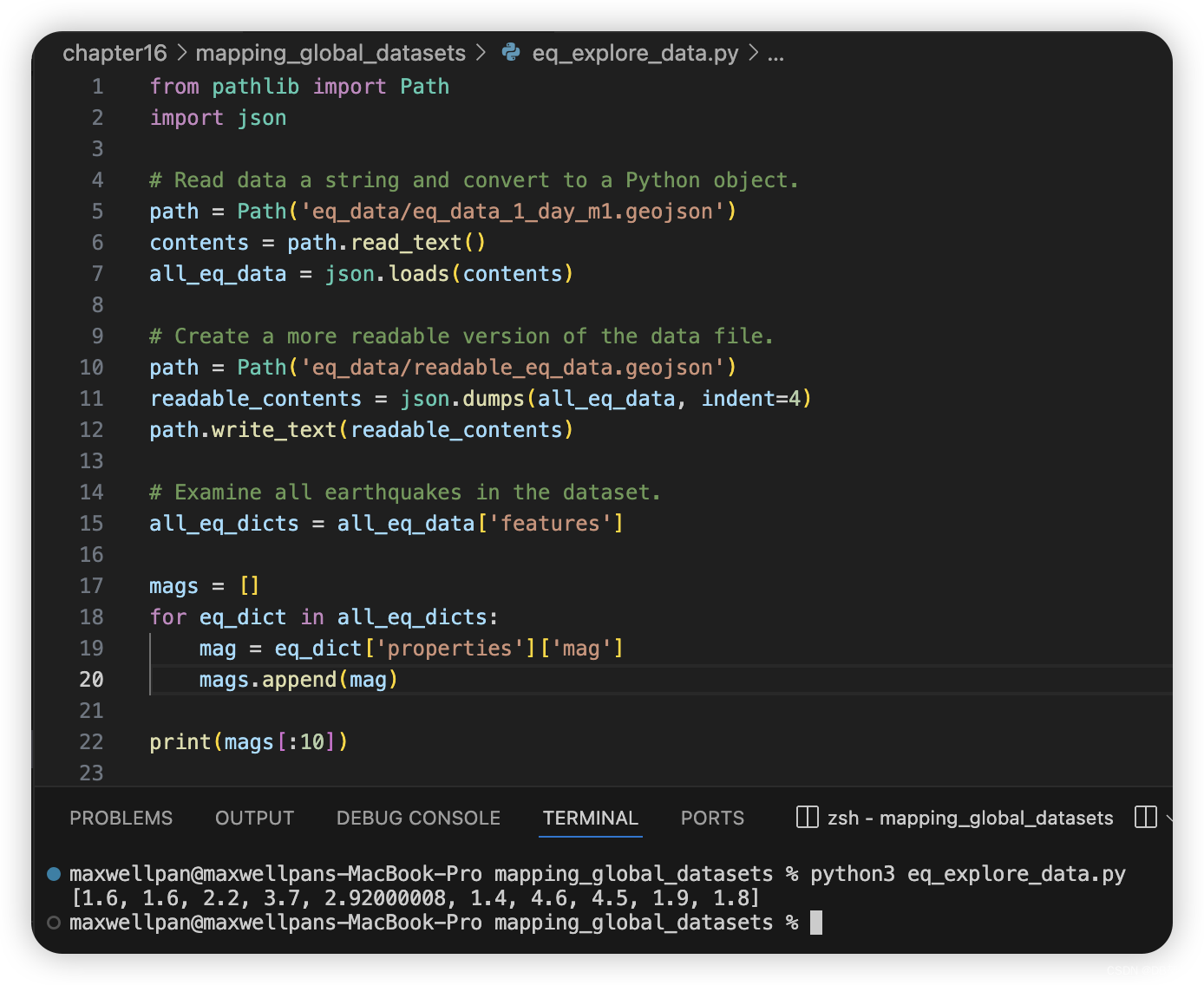
15.Extracting Location Data
from pathlib import Path
import json
# Read data a string and convert to a Python object.
path = Path('eq_data/eq_data_1_day_m1.geojson')
contents = path.read_text()
all_eq_data = json.loads(contents)
# Create a more readable version of the data file.
path = Path('eq_data/readable_eq_data.geojson')
readable_contents = json.dumps(all_eq_data, indent=4)
path.write_text(readable_contents)
# Examine all earthquakes in the dataset.
all_eq_dicts = all_eq_data['features']
mags, lons, lats = [], [], []
for eq_dict in all_eq_dicts:
mag = eq_dict['properties']['mag']
lon = eq_dict['geometry']['coordinates'][0]
lat = eq_dict['geometry']['coordinates'][1]
mags.append(mag)
lons.append(lon)
lats.append(lat)
print(mags[:10])
print(lons[:5])
print(lats[:5])
print(mags[:10])
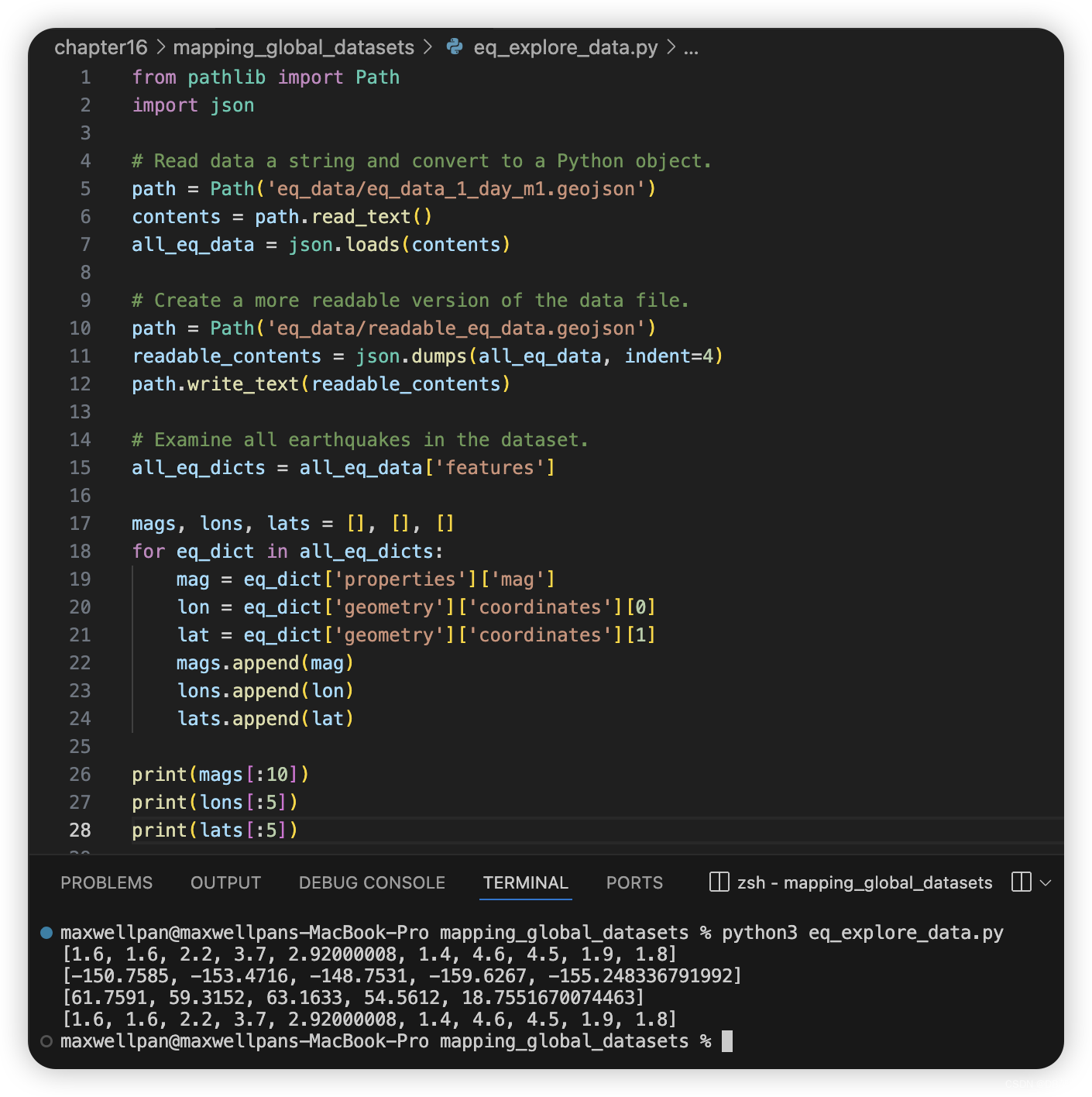
16.Building a World Map
from pathlib import Path
import json
import plotly.express as px
# Read data a string and convert to a Python object.
path = Path('eq_data/eq_data_1_day_m1.geojson')
contents = path.read_text()
all_eq_data = json.loads(contents)
# Create a more readable version of the data file.
path = Path('eq_data/readable_eq_data.geojson')
readable_contents = json.dumps(all_eq_data, indent=4)
path.write_text(readable_contents)
# Examine all earthquakes in the dataset.
all_eq_dicts = all_eq_data['features']
mags, lons, lats = [], [], []
for eq_dict in all_eq_dicts:
mag = eq_dict['properties']['mag']
lon = eq_dict['geometry']['coordinates'][0]
lat = eq_dict['geometry']['coordinates'][1]
mags.append(mag)
lons.append(lon)
lats.append(lat)
print(mags[:10])
print(lons[:5])
print(lats[:5])
print(mags[:10])
title = 'Global Earthquakes'
fig = px.scatter_geo(lat=lats, lon=lons, title=title)
fig.show()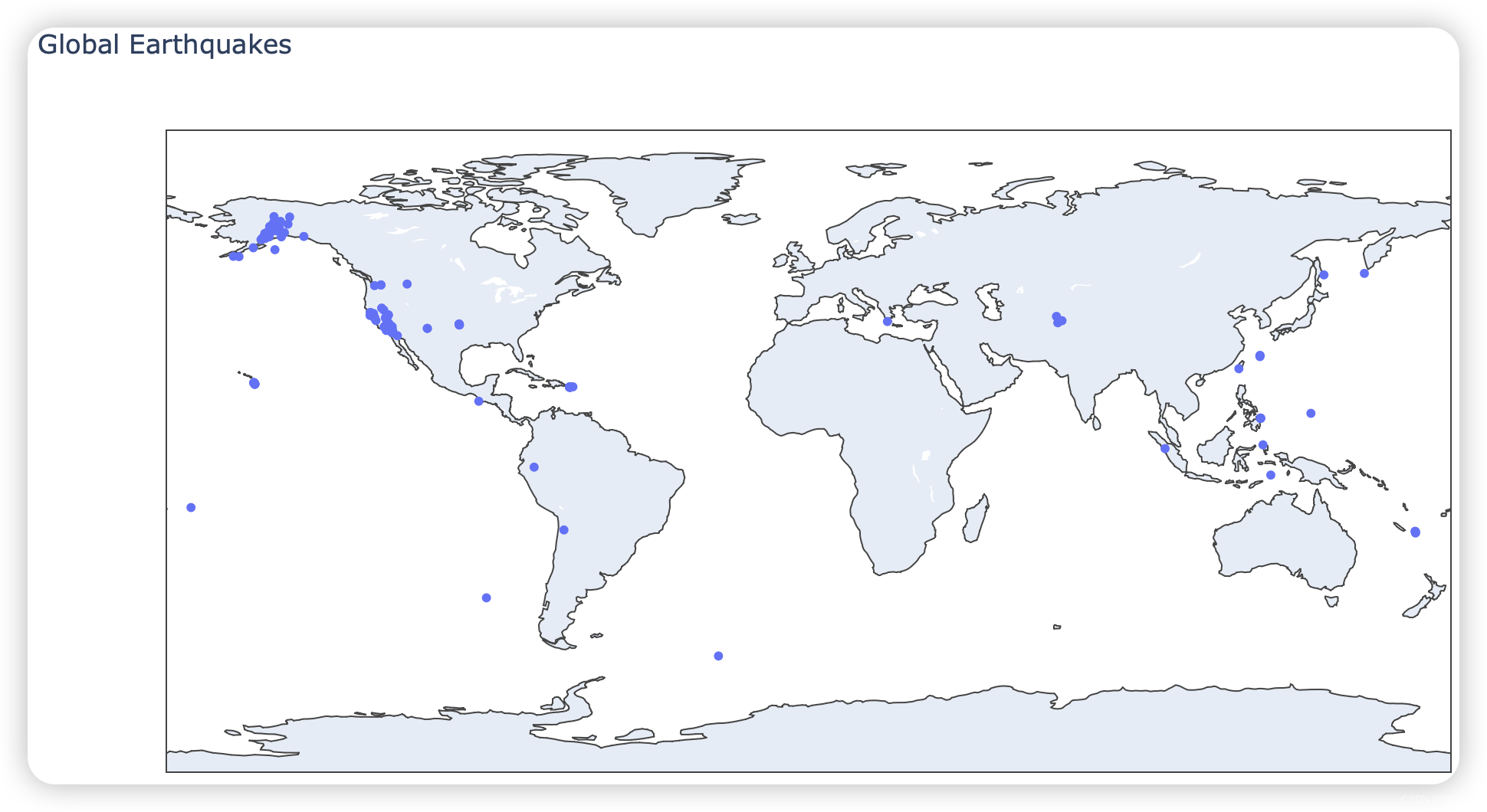
17. Representing Magnitudes
from pathlib import Path
import json
import plotly.express as px
# Read data a string and convert to a Python object.
path = Path('eq_data/eq_data_30_day_m1.geojson')
contents = path.read_text()
all_eq_data = json.loads(contents)
# Create a more readable version of the data file.
path = Path('eq_data/readable_eq_data.geojson')
readable_contents = json.dumps(all_eq_data, indent=4)
path.write_text(readable_contents)
# Examine all earthquakes in the dataset.
all_eq_dicts = all_eq_data['features']
mags, lons, lats = [], [], []
for eq_dict in all_eq_dicts:
mag = eq_dict['properties']['mag']
lon = eq_dict['geometry']['coordinates'][0]
lat = eq_dict['geometry']['coordinates'][1]
mags.append(mag)
lons.append(lon)
lats.append(lat)
print(mags[:10])
print(lons[:5])
print(lats[:5])
print(mags[:10])
title = 'Global Earthquakes'
fig = px.scatter_geo(lat=lats, lon=lons, size=mags, title=title)
fig.show()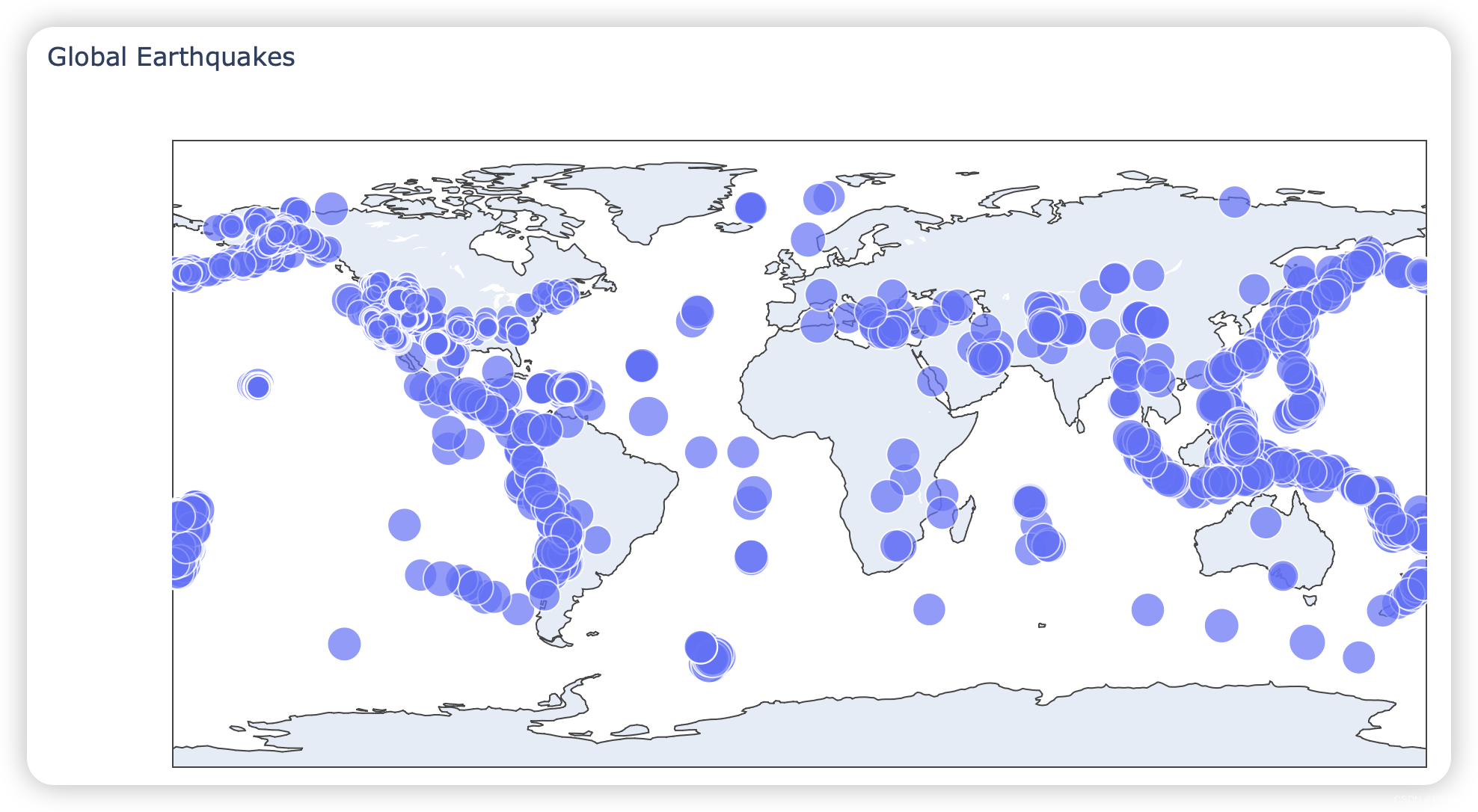
18. Customing Marker Colors
from pathlib import Path
import json
import plotly.express as px
# Read data a string and convert to a Python object.
path = Path('eq_data/eq_data_30_day_m1.geojson')
contents = path.read_text()
all_eq_data = json.loads(contents)
# Create a more readable version of the data file.
path = Path('eq_data/readable_eq_data.geojson')
readable_contents = json.dumps(all_eq_data, indent=4)
path.write_text(readable_contents)
# Examine all earthquakes in the dataset.
all_eq_dicts = all_eq_data['features']
mags, lons, lats = [], [], []
for eq_dict in all_eq_dicts:
mag = eq_dict['properties']['mag']
lon = eq_dict['geometry']['coordinates'][0]
lat = eq_dict['geometry']['coordinates'][1]
mags.append(mag)
lons.append(lon)
lats.append(lat)
print(mags[:10])
print(lons[:5])
print(lats[:5])
print(mags[:10])
title = 'Global Earthquakes'
fig = px.scatter_geo(lat=lats, lon=lons, size=mags, title=title,
color=mags,
color_continuous_scale='Viridis',
labels={'color':'Magnitude'},
projection='natural earth',)
fig.show()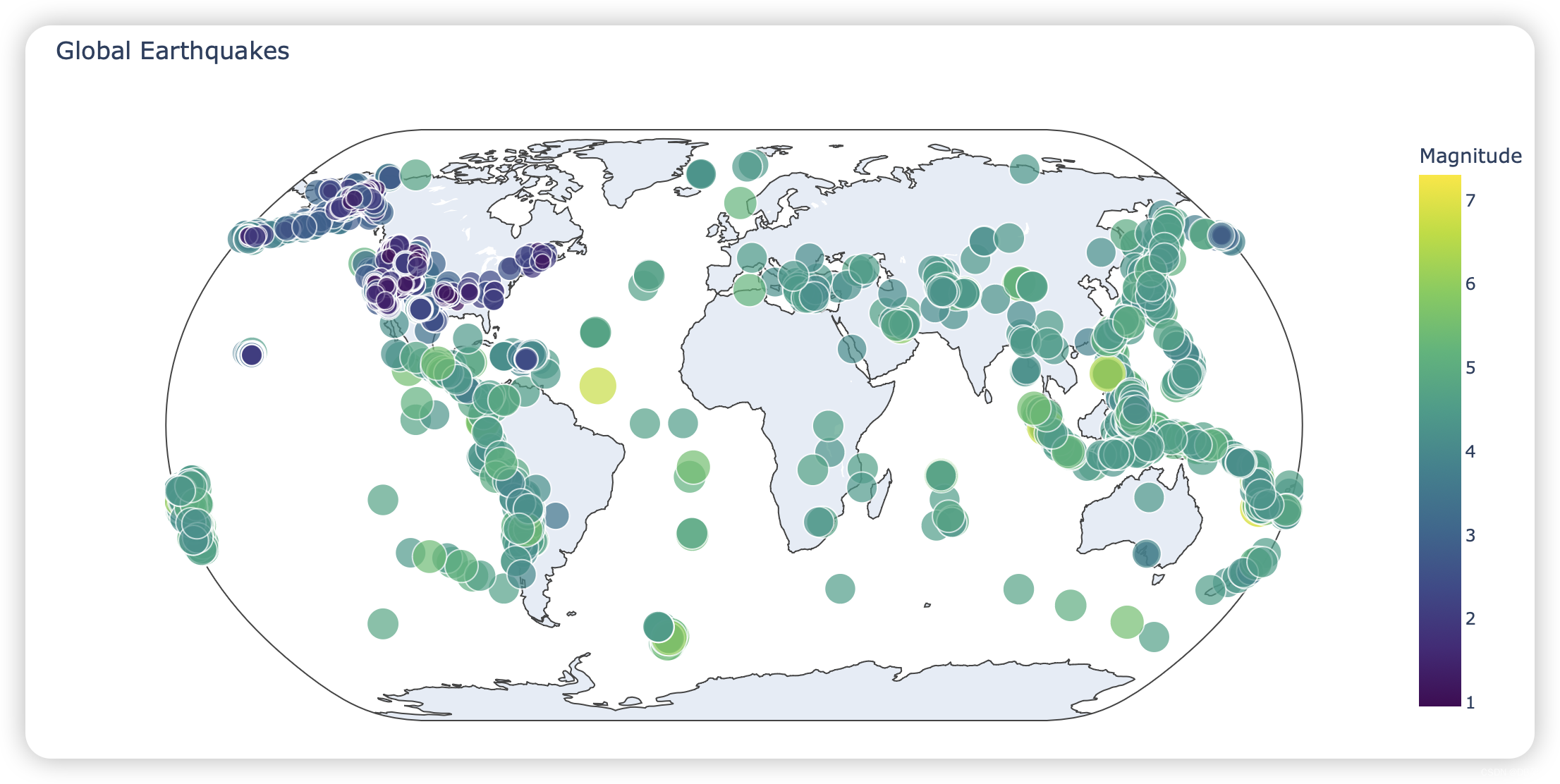
19.Other Color Scales
maxwellpan@192 mapping_global_datasets % python3
Python 3.12.2 (v3.12.2:6abddd9f6a, Feb 6 2024, 17:02:06) [Clang 13.0.0 (clang-1300.0.29.30)] on darwin
Type "help", "copyright", "credits" or "license" for more information.
>>> import plotly.express as px
>>> px.colors.named_colorscales()
['aggrnyl', 'agsunset', 'blackbody', 'bluered', 'blues', 'blugrn', 'bluyl', 'brwnyl', 'bugn', 'bupu', 'burg', 'burgyl', 'cividis', 'darkmint', 'electric', 'emrld', 'gnbu', 'greens', 'greys', 'hot', 'inferno', 'jet', 'magenta', 'magma', 'mint', 'orrd', 'oranges', 'oryel', 'peach', 'pinkyl', 'plasma', 'plotly3', 'pubu', 'pubugn', 'purd', 'purp', 'purples', 'purpor', 'rainbow', 'rdbu', 'rdpu', 'redor', 'reds', 'sunset', 'sunsetdark', 'teal', 'tealgrn', 'turbo', 'viridis', 'ylgn', 'ylgnbu', 'ylorbr', 'ylorrd', 'algae', 'amp', 'deep', 'dense', 'gray', 'haline', 'ice', 'matter', 'solar', 'speed', 'tempo', 'thermal', 'turbid', 'armyrose', 'brbg', 'earth', 'fall', 'geyser', 'prgn', 'piyg', 'picnic', 'portland', 'puor', 'rdgy', 'rdylbu', 'rdylgn', 'spectral', 'tealrose', 'temps', 'tropic', 'balance', 'curl', 'delta', 'oxy', 'edge', 'hsv', 'icefire', 'phase', 'twilight', 'mrybm', 'mygbm']
>>>
20.Adding Hover Text
from pathlib import Path
import json
import plotly.express as px
# Read data a string and convert to a Python object.
path = Path('eq_data/eq_data_30_day_m1.geojson')
contents = path.read_text()
all_eq_data = json.loads(contents)
# Create a more readable version of the data file.
path = Path('eq_data/readable_eq_data.geojson')
readable_contents = json.dumps(all_eq_data, indent=4)
path.write_text(readable_contents)
# Examine all earthquakes in the dataset.
all_eq_dicts = all_eq_data['features']
mags, lons, lats, eq_titles = [], [], [], []
for eq_dict in all_eq_dicts:
mag = eq_dict['properties']['mag']
lon = eq_dict['geometry']['coordinates'][0]
lat = eq_dict['geometry']['coordinates'][1]
eq_title = eq_dict['properties']['title']
mags.append(mag)
lons.append(lon)
lats.append(lat)
eq_titles.append(eq_title)
print(mags[:10])
print(lons[:5])
print(lats[:5])
print(mags[:10])
title = 'Global Earthquakes'
fig = px.scatter_geo(lat=lats, lon=lons, size=mags, title=title,
color=mags,
color_continuous_scale='Viridis',
labels={'color':'Magnitude'},
projection='natural earth',
hover_name=eq_titles,)
fig.show()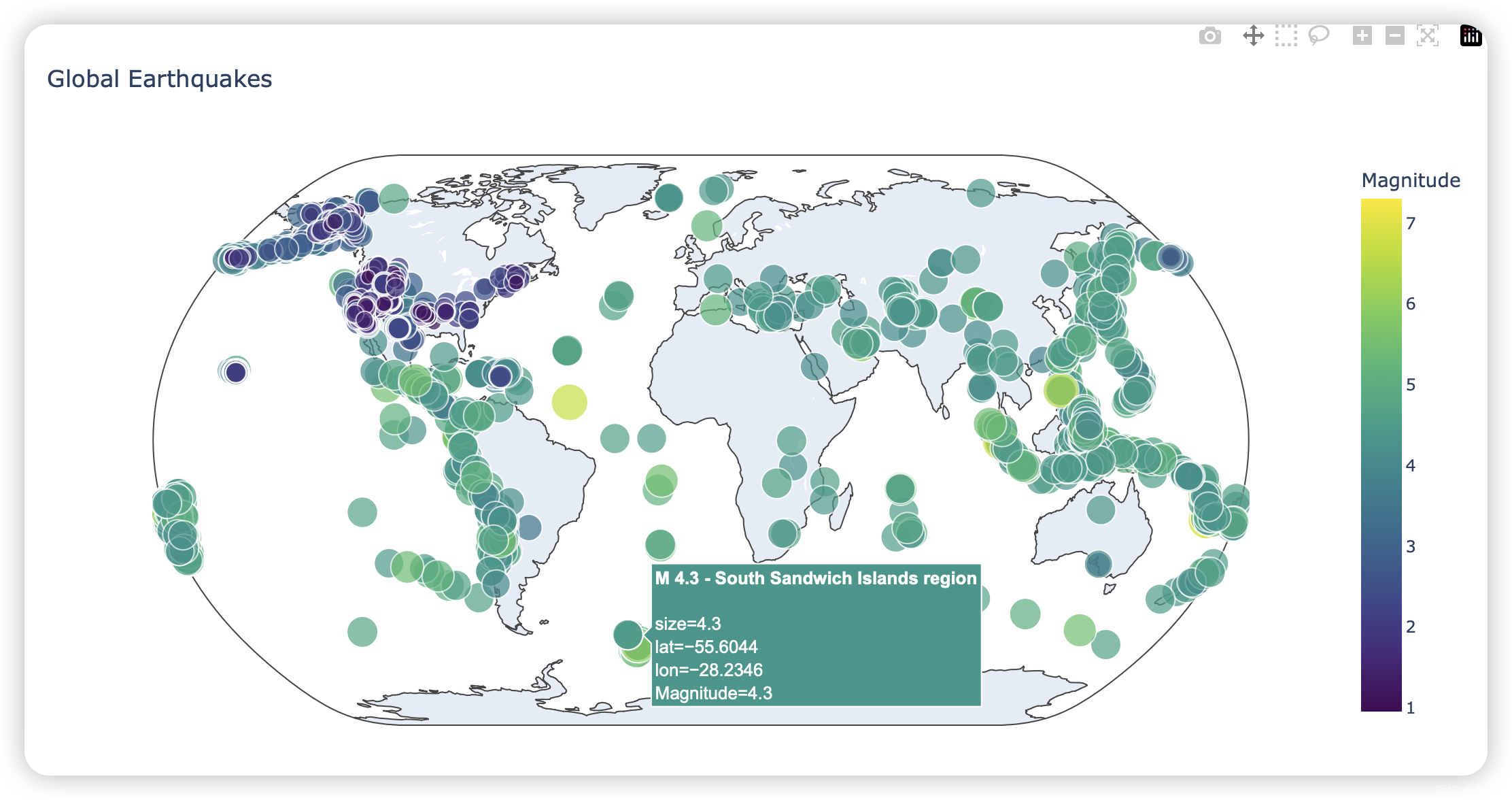
21.Summary
we learned how to work with real-world datasets.Ypi processed CSV and GeoJSON files, and extracted the data you want to focus on. Using historical weather data, we learned more about working with Matplotlib, including how to use the datetime module and how to plot multiple data series on one chart. We plotted geographical data on a world map in Plotly, and learned to cusotmize the style of the map.





















 749
749











 被折叠的 条评论
为什么被折叠?
被折叠的 条评论
为什么被折叠?








